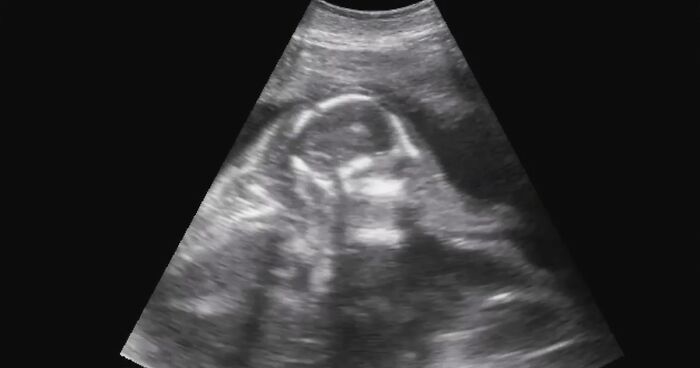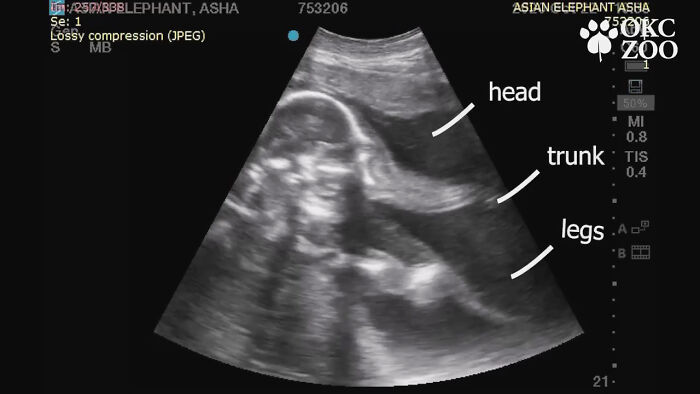
Zoo Shares An Ultrasound Of A Baby Elephant And People Find It Adorable
InterviewI think it’s safe to say that the internet is somewhat obsessed with adorable baby animals. Well, except maybe for the baby aye-ayes, but even those have their own charm!
So, it should come as no surprise that all animal baby-related things tend to get a relatively significant amount of attention from the internet, no matter if it’s already born or still curled up comfortably in its mother’s womb.
Enter Asha the female elephant and her recently published baby ultrasound that’s been circulating the internet. The explanatory video was posted by the Oklahoma City Zoo, with whom Bored Panda got in touch for an interview, and people find it both cute and fascinating.
The Oklahoma City Zoo recently showed what an ultrasound of a baby elephant looks like
Image credits: Oklahoma City Zoo and Botanical Garden
Meet Asha, the 25-year-old Asian elephant from the Oklahoma City Zoo who is expected to give birth to her fourth offspring in February of 2022. The father is the 51-year-old bull elephant named Rex, with whom Asha also has two other babies, 5-year-old Achara and 1-year-old Kairavi (or Kai for short).
A video of Asha’s ultrasound was published last week on the Oklahoma City Zoo and Botanical Garden’s Facebook page, stating the expected birth due day and that she’s already eight months into her 22-month pregnancy (around 660 days).
“Asha is unique in that she is very gentle, patient and eager to learn,” said Rachel Emory, Oklahoma City Zoo’s Curator of Elephants and Rhinos. ” She has raised three calves and is an excellent mother. Asha does an incredible job of allowing her calves to explore the Zoo’s elephant habitat and interact with other herd mates, while also always keeping them within her sight.”
“Along with her calves, Asha is very closely bonded to her sister, Chandra. Together, Asha, her calves, and Chandra make up a multigenerational herd with Bamboo, a geriatric female, and Kandula, an unrelated male. Watching Asha be a part of this herd is a truly incredible experience.”
The baby elephant in question is the offspring of two lovely Asian elephants, 25 Y.O. Asha and 51 Y.O. Rex
Image credits: Oklahoma City Zoo and Botanical Garden
Watch the video showcasing the ultrasound and the elephants below
The video caption read “A tiny trunk and little legs? This ultrasound is ultra-sweet! The Oklahoma City Zoo is thankful for 25-year-old Asha’s growing Asian elephant calf, due in February 2022.” They also took the opportunity to wish everyone a great thanksgiving.
Ultrasounds are a regular procedure to check on the elephant’s pregnancy and are conducted by the zoo’s veterinary team. The most recent ultrasound—the one seen in the video—concluded that both the mother and the baby are as healthy as they can be.
Unlike with human baby ultrasounds, which are often very hard to decipher, this one is surprisingly clear. The head, the trunk, and the legs are all vivid and easy to see, but the video also points out these parts for good measure.
Asha is one of several of the zoo’s female Asian elephants and currently a mother of 3
Image credits: Oklahoma City Zoo and Botanical Garden
Image credits: Oklahoma City Zoo and Botanical Garden
The ultrasound was done by the zoo’s vet team and it was said that both the mom and the baby are healthy
Image credits: Oklahoma City Zoo and Botanical Garden
Pregnancies as early as 8 months are very rarely announced as there’s still another 14 months to go, but the zoo’s veterinary team feels confident as both the mom and the baby are healthy and it’s her 4th pregnancy so far, making Asha an experienced mom by now. Her diet, exercise, and training continue to stay consistent throughout the pregnancy and she’s getting the best care an elephant could have.
“Probably more than any of the Zoo’s other elephants, Asha loves to eat! Her main diet consists of hay, grass and tree limbs—her personal favorite,” said Emory. “She also receives extra fruits and vegetables as positive reinforcement during all of her training sessions. All of these training sessions, like the ultrasound, are completely voluntary and allow us to safely and comfortably provide medical care for all of the elephants. Asha especially enjoys watermelon, cantaloupe and bananas during these sessions.”
In the ultrasound, one can clearly see the head, trunk and legs of the adorable baby elephant
Image credits: Oklahoma City Zoo and Botanical Garden
Image credits: Oklahoma City Zoo and Botanical Garden
Image credits: Oklahoma City Zoo and Botanical Garden
Asian elephants are considered endangered, meaning they have a high risk of extinction in the wild. The main cause of the current unfortunate conservation status is human-elephant conflict—on one hand, you have elephants requiring vast territories to live in, often finding themselves raiding crop fields, whilst humans are responsible for various kinds of deforestation.
Emory also elaborated on this issue: “Asian elephants are endangered and have lost 93% of their total habitat to date. Protecting their habitat and providing education, both here and in native range states, are the two greatest things we can do to help preserve these animals in the wild.”
“Due to a significant loss of habitat, humans and elephants frequently come into conflict over resources. Helping communities in range countries develop methods to reduce these conflicts will have a huge impact on elephant populations as well. Supporting Association of Zoos and Aquariums (AZA)-member zoos, like the Oklahoma City Zoo, helps provide education and monetary support for conservation projects across the globe.”
There are other reasons for this, namely poaching for ivory and skin, as well as disease, namely elephant endotheliotropic herpesvirus, a type of herpesvirus, which can cause a highly fatal hemorrhagic (bleeding) disease when transmitted to young Asian elephants. Unfortunately, this is exactly what happened to Asha’s firstborn Malee, who died of said disease at 4 years old.
Asha lives with 6 other elephants, which include Bamboo (the oldest one), her partner Rex, sister Chandra, Kandula, and daughters Achara, and Kairavi
Image credits: Oklahoma City Zoo and Botanical Garden
People online found the ultrasound absolutely adorable, saying things like “Seriously the cutest freaking little thing” and “That’s the most precious thing I’ve ever seen”.
Currently, the zoo is home to 7 elephants—Bamboo (53), Rex (51), Asha (25), Chandra (24), Kandula (18), Achara (5), Kairavi (1), and #8 is coming and is expected to come around in early 2022. You can meet more of the zoo’s inhabitants by visiting the Oklahoma City Zoo website and Facebook page.
We asked the Emory of the Oklahoma City Zoo what is one thing she wishes more people knew about about Asian elephants and she said this:
“Asian elephants are an incredibly intelligent species. They have very unique individual personalities, preferences, learning styles, social bonds and communication methods. Their herd structure and relationships with one another are fascinating and complex. Asian elephants are problem solvers, protectors, investigators and teachers all-in-one. I love that AZA-member zoos, like the Oklahoma City Zoo, provide opportunities for people to witness how truly amazing this species is and to help foster the desire to protect and conserve them in the wild”
Image credits: Oklahoma City Zoo and Botanical Garden
Check out a video posted by the zoo after Asha gave birth to her last daughter Kai (Kairavi)
And if you’re interested in learning more about Asian elephants and the disease that has a 60% mortality rate among them—the endotheliotropic herpesvirus—this video is for you
What are your thoughts on this? While you’re here, why not congratulate the elephant mother on her calf in the comment section below!
27Kviews
Share on Facebook
 Dark Mode
Dark Mode 

 No fees, cancel anytime
No fees, cancel anytime 



























































135
14